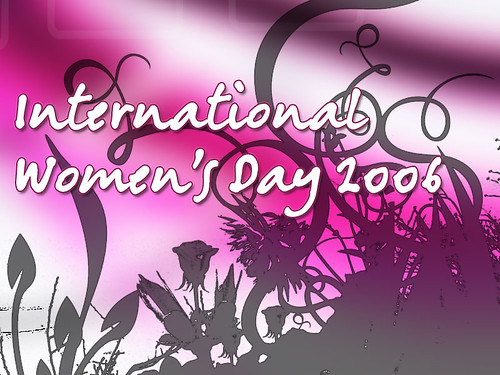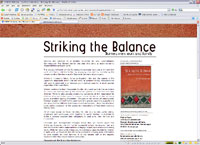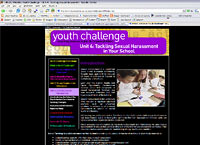
I was honoured to be asked to speak at an International Women’s Day function today at TAFE. It was lovely to put on my ‘human rights hat’ for a little while, and focus on achievements of women, and also the work that still needs to be done to ensure equality for all of us – both women and men.
I have published a little set of photos on flickr, and am hoping that the students might contribute some of their own.
I have also posted the text of my speech below for anyone who is interested.
Wishing everyone a very Happy International Women’s Day 2006!
 Speech: International Women’s Day 2006
Speech: International Women’s Day 2006
Firstly, I wanted to start by saying Happy International Women’s Day! Since the beginning of the 20th century, people from around the world have been coming together on this day to celebrate and protest for women’s rights, so we are taking part in a tradition that has a long and important history.
To introduce myself – my name is Jo Kay, and I work here at TAFE in the Teaching and Learning Resource unit. My work here is focused around eLearning, and web design. Before joining TAFE in September 2005, I spent nearly 6 years working at the Human Rights and Equal Opportunity Commission – my role there involved managing their websites and online services, and also developing and coordinating their human rights education program for secondary schools.
One of the wonderful things about working at the Human Rights Commission was the opportunity to work on a range of projects that focused on improving human rights and equality for all people in Australia – including some projects that focused on the rights of women.
So, with that in mind, I thought I’d highlight some of HREOC’s recent projects that focused on advancing the rights of women and promoting equality. As I’m a self-confessed Internet addict, the focus will be on online projects and websites where you can find more information. For those of you who would like to follow up and learn more, I’ve put together a list of links. There are copies floating around for anyone who’d like to check it out.
But first – some history….
International Women’s Day is marked on 8 March every year. It is a major day of global celebration of the economic, political and social achievements of women
The history of International Women’s Day dates back to 1910 internationally and, in Australia, to 1928. However, it was socialist women in the United States who organised the first national Women’s Day in 1908 and helped to inspire the international event.
In 1910, the first international women’s conference was held in Copenhagen by the Socialist International movement and an International Women’s Day was proposed by German Socialist Clara Zetkin. The following year, International Women’s Day was marked by over a million people in Austria, Denmark, Germany and Switzerland.
Today, International Women’s Day is celebrated all over the world, and it’s a time when women get together to remember the interests that we have in common and to remember the struggles in the past that women have had in common. It commemorates a strike, an organised action by women protesting about working conditions, but it also marks the positive achievements of women around the world. It’s a time to celebrate the fun of women getting together, and its an occasion when a political, a social and an economic statement is being made about the collective interests of women.
Visit Wikipedia for more information on the history of International Women’s Day.
Women’s Rights – The Facts:
As well as celebrating, it is important to consider the issues that still face women around the world. The following statistics were compiled by the United Nations Department of Public Information in 1997, and provide a clear indication of the work still to be done.
Status of Women
- Of the world’s 1.3 billion poor people, it is estimated that nearly 70 per cent are women.
- Between 75 and 80 per cent of the world’s 27 million refugees are women and children.
Political Participation
- Women hold 11.7 per cent of the seats in the world’s parliaments.
Women and Education
- Of the world’s nearly one billion illiterate adults, two-thirds are women.
- Two-thirds of the 130 million children worldwide who are not in school are girls.
- During the past two decades the combined primary and secondary enrollment ratio for girls in developing countries increased from 38 per cent to 78 per cent.
Women and Labour
- The majority of women earn on average about three-fourths of the pay of males for the same work, in both developed and developing countries.
- In most countries, women work approximately twice the unpaid time men do.
- Women make up 31 per cent of the official labour force in developing countries and 46.7 per cent worldwide.
- The value of women’s unpaid housework and community work is estimated at between 10-35 per cent of GDP worldwide, amounting to $11 trillion in 1993.
Women and Health
- Women are becoming increasingly affected by HIV. Today about 42 per cent of estimated cases are women.
- An estimated 20 million unsafe abortions are performed worldwide every year, resulting in the deaths of 70,000 women.
- Approximately 585,000 women die every year, over 1,600 every day, from causes related to pregnancy and childbirth.
Women and Violence
- Each year an estimated two million girls suffer the practice of female genital mutilation.
- Worldwide, 20 to 50 per cent of women experience some degree of domestic violence during marriage.
- The primary victims of today’s wars are civilian women and their children, not soldiers.
- The use of rape as a weapon of war has become more evident. In Rwanda from April 1994 to April 1995, estimates of the number of women and girls raped range from 15,000 to over 250,000.
Women’s Rights in Australia
So now that we’ve looked at some pretty depressing statistics, let’s look at what’s happening in Australia to advance the rights of women and to improve equality for all people.
There are a number of organizations in Australia that work to improve the status of women in our community, and to address these issues. Today I’m going to focus on projects undertaken by the Human Rights and Equal Opportunity Commission.
The federal Sex Discrimination Commissioner – currently Pru Goward, is part of the Human Rights and Equal Opportunity Commission. Her role is to:
- promote equality between men and women;
- eliminate discrimination on the basis of sex, marital status or pregnancy; and to
- eliminate sexual harassment at work, in educational institutions, in the provision of goods and service, in the provision of accommodation and the administration of federal programs.
You can read a statement from the Sex Discrimination Commissioner to commemorate International Women’s Day on the HREOC website. Recent Projects undertaken by the Sex Discrimination Commissioner
Recent Projects undertaken by the Sex Discrimination Commissioner
To give you an idea of the work undertaken at HREOC to promote equality for men and women, I thought I would point to a couple of recent projects undertaken by the Sex Discrimination Commissioner.
‘Striking the Balance: Women, men, work and family’. It explores men’s and women’s choices for balancing their competing work and family responsibilities. Men and women from all over Australia have been invited to make submissions on issues around family, gender and work balance. These submissions will be compiled into a report later on this year.
 Sexual Harassment in the Australian Workplace was a project that explored Workplace sexual harassment, including the results of a national telephone survey which found that more than one in four Australians have been sexually harassed. The project included production of a Code of Practice that can be used by employers in both small and large businesses to ensure that their workplace is free from sexual harassment.
Sexual Harassment in the Australian Workplace was a project that explored Workplace sexual harassment, including the results of a national telephone survey which found that more than one in four Australians have been sexually harassed. The project included production of a Code of Practice that can be used by employers in both small and large businesses to ensure that their workplace is free from sexual harassment.Youth Challenge – Tackling Sexual Harassment in Your School is a human rights education resource focused on educating young people about how to identify and deal with sexual harassment. The resource includes videos, worksheets and other useful information that can be used by teachers and parents.
 There are a range of other organizations working to promote equality in our community including: Commonwealth Office for Women, the NSW Office or Women, Equal Opportunity for Women in the Workplace Agency, the Women’s Rights Action Network of Australia, the Rural Women’s Network, the National Women’s Justice Coalition, the Immigrant Women’s Speak Out Association, and the Women’s Electoral Lobby.
There are a range of other organizations working to promote equality in our community including: Commonwealth Office for Women, the NSW Office or Women, Equal Opportunity for Women in the Workplace Agency, the Women’s Rights Action Network of Australia, the Rural Women’s Network, the National Women’s Justice Coalition, the Immigrant Women’s Speak Out Association, and the Women’s Electoral Lobby.
I urge you to check out some of these websites to find out more about the current status of women in Australia.
I’ve included web links to these organization in the handout, along some links to International Organisations including the UNIFEM – the women’s fund at the United Nations, the United Nations Women’s Watch, Amnesty International, International Museum of Women and the Girls Go Global project.
To finish, I thought I’d share my own perspective on International Women’s Day.
I believe that gender equality is, first and foremost, a human right. It is both a men’s and a women’s issue.
International Women’s Day is a wonderful time for all of us – both women and men to reflect on the status of women and the importance of equality – not only in our own local communities, but around the world.
Thanks very much for listening.
0 Comments